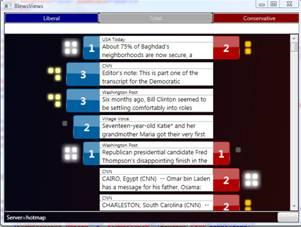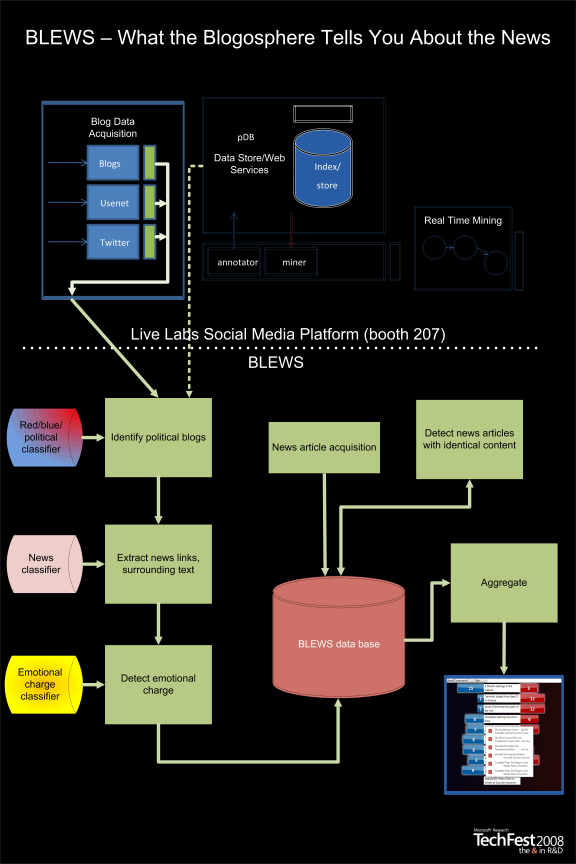 While typical news-aggregation sites do a good job of clustering news stories according to topic, they leave the reader without information about which stories figure prominently in political discourse. BLEWS uses political blogs to categorize news stories according to their reception in the conservative and liberal blogospheres. It visualizes information about which stories are linked to from conservative and liberal blogs, and it indicates the level of emotional charge in the discussion of the news story or topic at hand in both political camps. BLEWS also offers a “see the view from the other side” functionality, enabling a reader to compare different views on the same story from different sides of the political spectrum. BLEWS achieves this goal by digesting and analyzing a real-time feed of political-blog posts provided by the Live Labs Social Media platform, adding both link analysis and text analysis of the blog posts.
While typical news-aggregation sites do a good job of clustering news stories according to topic, they leave the reader without information about which stories figure prominently in political discourse. BLEWS uses political blogs to categorize news stories according to their reception in the conservative and liberal blogospheres. It visualizes information about which stories are linked to from conservative and liberal blogs, and it indicates the level of emotional charge in the discussion of the news story or topic at hand in both political camps. BLEWS also offers a “see the view from the other side” functionality, enabling a reader to compare different views on the same story from different sides of the political spectrum. BLEWS achieves this goal by digesting and analyzing a real-time feed of political-blog posts provided by the Live Labs Social Media platform, adding both link analysis and text analysis of the blog posts.
-
Our current visualization shows the count of liberal inlinks to a news article as a blue “wing” on the left, and the number of conservative inlinks as a red “wing” on the right. The emotional charge of the discussion around the news link is shown as a “heat indicator” on the outside of the wings. Emotional charge ranges from a single orange square to four white-hot squares. Clicking on the wings produces a dropdown of the individual blog posts linking to the news article. In the dropdown, emotionally charged posts have a fuzzy border, while emotionally neutral posts have a solid border.

-
The data we mine in the Blews system is provided by the LiveLabs Social Media Platform. We consume the blog feed from that platform and first identify political (liberal/independent/conservative) blog posts. From those posts, we extract links to news articles and the text in the posts that surround the news links. We apply a classifier to that text, determining the emotional charge. The data is then imported into our database, and the news articles are crawled. We also apply a duplicate detection algorithm to the news articles, in order to detect stories that contain the same syndicated content or are linked to through diffent URLs. Finally, the content of the database is aggegated and visualized.

People
Sumit Basu
Senior Principal Researcher
Arnd Christian König
Principal Researcher
